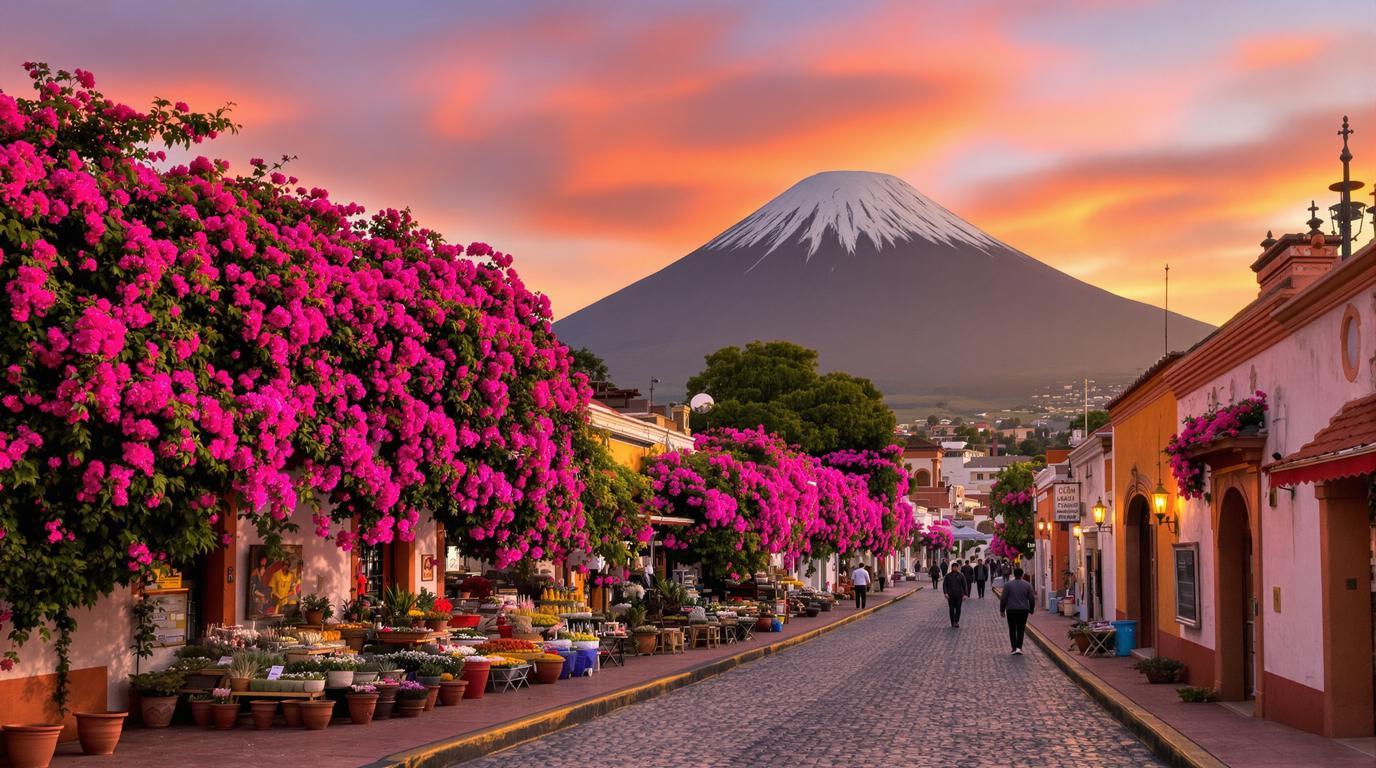Mexico’s vibrant culture and rich history often draw visitors to well-known destinations like Cancún or Mexico City. Yet, just 30 kilometers southwest of Puebla City lies a captivating treasure that many travelers overlook. Atlixco – a town where the majestic Popocatépetl volcano creates a dramatic backdrop to colorful colonial buildings and flower-filled streets.
The town where flowers reign supreme
Designated as one of Mexico’s coveted “Pueblos Mágicos” (Magical Towns), Atlixco has earned the nickname “City of Flowers” for good reason. The town’s microclimate makes it ideal for cultivating vibrant blooms year-round, transforming streets and gardens into botanical wonders. The Jardín Mágico showcases this floral abundance with topiary animals and rare plant collections that would impress even seasoned garden enthusiasts.
A colonial gem with 300-year-old architectural treasures
Walking through Atlixco feels like stepping back through centuries of Mexican history. The stunning 18th-century Capilla Del Cerro De San Miguel perches above the town, rewarding those who climb its steps with panoramic views that stretch for miles. The colorful buildings lining the streets showcase a perfect blend of indigenous and European architectural influences that have stood the test of time.
“Our town preserves traditions that modern cities have forgotten. When you sit in our zócalo, you’re experiencing Mexico as it was meant to be enjoyed—unhurried and with your senses fully engaged,” shares María Gonzalez, a lifelong Atlixco resident.
The vibrant soul of the zócalo
The town’s central plaza buzzes with activity from dawn till dusk. Local vendors sell everything from handcrafted souvenirs to regional treats, while the sounds of mariachi musicians occasionally fill the air. Unlike the touristic squares of more commercialized destinations, Atlixco’s zócalo remains authentically Mexican.
A stairway to cultural immersion
La Escalera Ancha isn’t just any staircase—it’s a vibrant, mural-adorned pathway leading to some of the town’s most scenic viewpoints. These colorful steps tell stories of local folklore and history, connecting visitors to the base of Cerro de San Miguel in a journey that mirrors ancient pathways in other culturally rich destinations.
Taste the authentic flavors of Puebla
Atlixco’s culinary scene offers genuine regional specialties without the tourist markup. The local market, Mercado Benito Juárez, presents an aromatic adventure where visitors can sample enchiladas de mole, cecina (salted beef), and refreshing licuado de mamey. Each dish tells a story of cultural fusion that began centuries ago.
“Our mole recipes are passed down through generations. When tourists taste it, they’re experiencing history through flavor,” explains José Luis Ramírez, a local chef who has cooked traditional dishes for over 40 years.
The festival that captivates all senses
For travelers fortunate enough to visit in late September, the Huey Atlixcáyotl Festival offers a cultural spectacle that rivals celebrations in more famous heritage sites. Traditional dancers in elaborate costumes perform against the backdrop of Atlixco’s colonial architecture, creating a sensory feast that showcases the region’s indigenous roots.
Morning reflections of Popocatépetl
Early risers are rewarded with the most magical sight in Atlixco—dawn light illuminating the snow-capped Popocatépetl volcano. This stunning view rivals Japan’s most breathtaking morning reflections, creating a memory that lingers long after visitors return home.
Diversity beneath the surface
Beyond its cultural attractions, Atlixco offers unexpected ecological diversity. The region’s varied landscapes support a surprising array of flora and fauna. While not quite as diverse as Africa’s most biodiverse lake ecosystems, Atlixco’s natural areas provide a refreshing counterpoint to its cultural attractions.
In Atlixco, authentic Mexico reveals itself not through grand tourist attractions but through the rhythms of daily life, the smiles of locals, and traditions that have endured for centuries. Here, visitors don’t just observe Mexican culture—they become immersed in it, one colorful street, flavorful bite, and warm conversation at a time.
